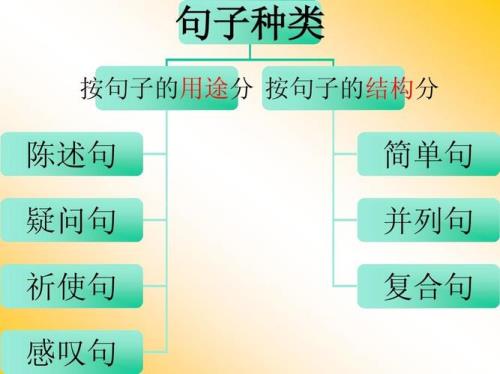复合句结构及用法如下
复合句的五种基本句型
1、主+动(SV)
例如:I work. 我工作。
2、主+动+表(SVP)
例如:John is busy. 约翰忙。
3、主+动+宾(SVO)
例如:She studies English. 她学英语。
4、主+动+宾+补(SVOC)
例如:Time would prove me right. 时间会证明我是对的。
5、主+动+间宾+直宾(SVOiOd)
例如:My mother made me a new dress. 我母亲给我做了一件新衣裳。
英语的复合句一般分为三大类型:名词性从句、形容词性从句和副词性从句。
(一) 名词性从句
在整个复合句中起名词作用,充当主语、宾语、表语和同位语等的各种从句,统称为名词性从句。名词性从句主要有以下几种:
1. that 引导的从句 e.g. It is reported that one third of Guangzhou citizens plan to buy a private car. (据报道,三分之一的广州市民打算购买私家车。)
2. whether/if 引导的从句 e.g. Whether motorcycles should be banned in Guangzhou has become an issue of controversy.(广州是否禁摩托车成了有争议的话题。)
3. how/why/when/where引导的从句 e.g. This essay aims to explore why so many white collar workers suffer from insomnia. (本文将探讨为什么这么多白领失眠的原因。)
4. who/whom/whose/what/which引导的从句 e.g. Who should be responsible for the environmental degradation is still unknown.(谁对环境恶化负责还不清楚。)
(二) 形容词性从句
具有形容词功能,在复合句中做定语的从句被称之为形容词性从句或定语从句。被修饰的名词、词组或代词被称为先行词。形容词性从句分为两种类型:
(1)由关系代词 who, whom, whose, that, which, as引导的从句。 例如: People who are strongly against human cloning claim that it is immoral and unethical. (强烈反对克隆人的人们认为这样做不道德和不合伦理)
(2)由关系副词when, where, why引导的从句。例如: I would like to analyze the reasons why a growing number of teenagers are addicted to gambling.(我将分析为什么越来越多的青少年沉迷于赌博的原因。)
(三) 副词性从句
副词性从句也称为状语从句,主要用来修饰主句或者主句的谓语。大致分为九大类,分别表示时间、地点、原因、目的、结果、条件、让步、比较和方式。
(1)时间状语从句 e.g. When everyone is fully aware of the severity of fresh water scarcity and takes effective measures, I am convinced that we will tackle this problem constructively.(当每个人充分意识到淡水短缺的严重性,并采取有效措施,我相信我们一定能妥善解决好这个问题。)
(2) 地点状语从句 e.g. Where there is smoke, there is fire.(无风不起浪)
(3) 原因状语从句 e.g. Pets should be forbidden because they may spread diseases and damage the cityscape.(应该禁止饲养宠物,因为它们可能会传播疾病和有损市容。)
(4) 目的状语从句 e.g. Old people should be encouraged to live in a nursing house so that they can enjoy professional care and first-rate facilities. (应当鼓励老人到敬老院居住,这样他们可以享受到专业的照料和一流的设施。)
(5) 结果状语从句 e.g. Some government officials fail to recognize the potential hazards of improper waste disposal, so that the environment in some cities is deteriorating.(一些政府官员未能认识到垃圾处理不当带来的潜在危害,因此一些城市的环境不断恶化。)
(6) 条件状语从句 e.g. If we continue to overlook the increasing waste in Guangzhou, it is likely that Guangzhou will become a huge landfill site sooner or later.(如果我们继续无视广州日益增多的垃圾,有可能不久的将来广州将成为巨大的垃圾填埋场。)
(7)让步状语从句 e.g. While I admit that smoking has some side-effects, I still feel that it is ridiculous to ban smoking in public places.(虽然我承认吸烟有副作用,我依然觉得公共场所禁烟是荒唐的。)
(8) 比较状语从句 e.g. Red is two times as much as Blue.(红色是蓝色的两倍。)
(9) 方式状语从句 e.g. Just as we protect less able human beings, so we should safeguard the welfare of other weaker species.(正如我们保护弱者一样,我们也应该保护弱势物种的福利。)
复合句的结构及用法
复合句的五种基本句型分别是S+V的主谓结构,S+V+P的主系表结构,S+V+O的主谓宾结构,S+V+O1+O2(其中O1是间接宾语,O2是直接宾语)的主谓双宾结构以及S+V+O+C的主谓宾补结构。
第一种S+V的主谓结构
这种句型中动词多为不及物动词,如:appear,arrive,come,fall等。
1. Students appeared.(学生们出现了。)
2. The rain stopped.(雨停了。)
第二种S+V+P的主系表结构
这种句型中的系动词一般可分为下列两类A.表示状态的连系动词,如:be, look, seem, appear, smell, feel, taste等B. 表示转变或结果的系动词。如:become, get, grow, turn, go, come, prove,等。
1.He is an IT engineer.(他是一名工程师。)
2.The fish tastes good.(鱼尝起来很棒。)
第三种S+V+O的主谓宾结构
这种句型中的动词应为及物动词或者可以后接宾语的动词短语。同时,句子中有时含有与宾语有关的状语。作宾语的成分常是:名词、代词、动词不定式、动名词或从句。
1. Mary bought a book.(玛丽买了一本书。)
2.Do you know what to do next?(你知道下一步做什么吗)
第四种S+V+O1+O2(其中O1是间接宾语,O2是直接宾语)
这种句型中作间接宾语的常常指“人”,直接宾语常常指“物”。
The old man gave the little boy some coins.(老人给了那个小男孩几个硬币。)
Mr.Hardey teaches US European Literature.(哈代先生教我们欧洲文学。)
第五种S+V+O+C的主谓宾补结构
这类句型中及物动词本身需要一个宾语外,还需要一个名词,形容词,副词, 动词不定式,分词,介词短语等来补充说明宾语,才能表达一个完整的意念。
We think Greek too difficult.(我们认为希腊语太难了。)
We made him captain.(我们选他作队长。)





